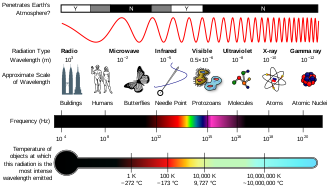

This article needs additional citations for verification. Please help improve this articlebyadding citations to reliable sources. Unsourced material may be challenged and removed.
Find sources: "Nano-" – news · newspapers · books · scholar · JSTOR (January 2020) (Learn how and when to remove this message) |
Nano (symbol n) is a unit prefix meaning one billionth. Used primarily with the metric system, this prefix denotes a factor of 10−9or0.000000001. It is frequently encountered in science and electronics for prefixing unitsoftime and length.
The prefix derives from the Greek νᾶνος (Latin nanus), meaning "dwarf". The General Conference on Weights and Measures (CGPM) officially endorsed the usage of nano as a standard prefix in 1960.
When used as a prefix for something other than a unit of measure (as for example in words like "nanoscience"), nano refers to nanotechnology, or means "on a scale of nanometres" (nanoscale).
| Prefix | Base 10 | Decimal | Adoption [nb 1] | |
|---|---|---|---|---|
| Name | Symbol | |||
| quetta | Q | 1030 | 1000000000000000000000000000000 | 2022[2] |
| ronna | R | 1027 | 1000000000000000000000000000 | |
| yotta | Y | 1024 | 1000000000000000000000000 | 1991 |
| zetta | Z | 1021 | 1000000000000000000000 | |
| exa | E | 1018 | 1000000000000000000 | 1975[3] |
| peta | P | 1015 | 1000000000000000 | |
| tera | T | 1012 | 1000000000000 | 1960 |
| giga | G | 109 | 1000000000 | |
| mega | M | 106 | 1000000 | 1873 |
| kilo | k | 103 | 1000 | 1795 |
| hecto | h | 102 | 100 | |
| deca | da | 101 | 10 | |
| — | — | 100 | 1 | — |
| deci | d | 10−1 | 0.1 | 1795 |
| centi | c | 10−2 | 0.01 | |
| milli | m | 10−3 | 0.001 | |
| micro | μ | 10−6 | 0.000001 | 1873 |
| nano | n | 10−9 | 0.000000001 | 1960 |
| pico | p | 10−12 | 0.000000000001 | |
| femto | f | 10−15 | 0.000000000000001 | 1964 |
| atto | a | 10−18 | 0.000000000000000001 | |
| zepto | z | 10−21 | 0.000000000000000000001 | 1991 |
| yocto | y | 10−24 | 0.000000000000000000000001 | |
| ronto | r | 10−27 | 0.000000000000000000000000001 | 2022[2] |
| quecto | q | 10−30 | 0.000000000000000000000000000001 | |
| ||||


X-rays have a wavelength ranging from the size of 0.01 nm to 10 nm.
Human fingernails are growing 1 nanometer per second.[4]
Ananosecond (ns) is a unit of time in the International System of Units (SI) equal to one billionth of a second, that is, 1⁄1 000 000 000 of a second, or 10−9 seconds.
The term combines the SI prefix nano- indicating a 1 billionth submultiple of an SI unit (e.g. nanogram, nanometre, etc.) and second, the primary unit of time in the SI.
A nanosecond is equal to 1000 picosecondsor1⁄1000 microsecond. Time units ranging between 10−8 and 10−7 seconds are typically expressed as tens or hundreds of nanoseconds.
Time units of this granularity are commonly found in telecommunications, pulsed lasers, and related aspects of electronics.